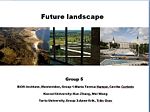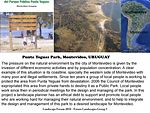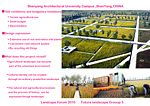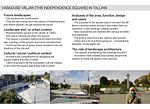Future Landscapes Group 5: Difference between revisions
No edit summary |
Heike.kaiser (talk | contribs) |
||
| (17 intermediate revisions by 3 users not shown) | |||
| Line 13: | Line 13: | ||
Comment to work of Kassel from Montevideo: | Comment to work of Kassel from Montevideo: | ||
The necessity of food production in a country with limited tillable land makes that a simple rice paddy, being just a cultivable territory, becomes part of the cultural identity of China and transforms itself in a possible target-landscape for the nation. | The necessity of food production in a country with limited tillable land makes that a simple rice paddy, being just a cultivable territory, becomes part of the cultural identity of China and transforms itself in a possible target-landscape for the nation. | ||
Comment to work of Tartu from Montevideo: | |||
The Independence Square in Tallinn is a typical example for an urban space with an important history and which needs to connect different parts of the city. As far as society needs a place which represents it, these squares will be part of our future landscape. | |||
<DPL> | <DPL> | ||
| Line 23: | Line 26: | ||
Comment to work of Kassel from Montevideo: | Comment to work of Kassel from Montevideo: | ||
The Shenyang Architectural University Campus in China is a very good example for the study of a case that soon will be a problem for all the world. Thought in these terms, it is clear that for the concept of landscape the aesthetic component would not be so much important. A landscape architecture ought to redefine its role towards this situation. | The Shenyang Architectural University Campus in China is a very good example for the study of a case that soon will be a problem for all the world. Thought in these terms, it is clear that for the concept of landscape the aesthetic component would not be so much important. A landscape architecture ought to redefine its role towards this situation. | ||
Comment to work of Tartu from Montevideo: | |||
Just in September 2010 a group of architects won the architectural competition for the redesign of our Independence Square in Montevideo. Citizens of Montevideo are now looking at the plans. And many people say: Who did ask us what we wanted? | |||
And we ask you, if the problems with the Statue of Liberty in the Square of Tallinn did not happen because people were not consulted before the redesign. Maybe the role of a landscape architect in such a project should consider the public consultation like in the Punta Yeguas Park. | |||
<DPL> | <DPL> | ||
| Line 33: | Line 41: | ||
*Which major similarities and differences could you identify in those two case studies? | *Which major similarities and differences could you identify in those two case studies? | ||
'' | ''In our group, three cases focus on totelly different aspects.The difference between three cases are much more obvious and worth identifing.So we collect the differences and compare them from six aspects. Especially, when put the attributes of one case to another, it inspires much more.(concept map)'' | ||
<gallery caption=" " widths="150px" heights="150px" perrow="3"> | |||
Image:finalcompare.jpg| difference identitied by the cases study | |||
</gallery> | |||
== Synthesis and Outlook == | == Synthesis and Outlook == | ||
'' | ''When we had to face the issue of the future landscape, we tried to identify first the changes, or what we also can call the new challenges. Then we indicated how the landscape reacted facing all this challenges. With all this inputs we illustrated how our future landscape should be. This way helped us to make the conclusions after our three cases study (concept map). | ||
The case studies we show, do not represent exactly the future landscapes we desire, because they don′t represent all the aspects we are looking for, just as economical, nature, aesthetics, cultural, rural, and so on. | |||
We selected each case, because we think that every case represents for us a very important issue to integrate in future landscape planning: | |||
*In Punta Yeguas Park: the active participation of citizens in the planning of landscape | |||
*In Shenyang Campus: the focus on survival issue | |||
*In the Square of Tallinn: the importance of cultural heritage '' | |||
<gallery caption=" " widths="150px" heights="150px" perrow="4"> | |||
Image:11111.jpg| | |||
Image:PuntaYeguasPark.jpg| Punta Yeguas Park introduction | |||
Image:kassel-case.jpg| Shenyang Architectural University Campus introduction | |||
Image:Vabaduse v2ljak slide.jpg| Vabaduse Väljak (Independence Square) in Tallinn introduction | |||
Image:finalcompare.jpg|compare | |||
Image:final_future_landscape.jpg| future landscape | |||
Image:group5-2.jpg| | |||
</gallery> | |||
[[#toc|'''Back to top''']] | [[#toc|'''Back to top''']] | ||
[[Category:Assignment Future Landscapes]] | [[Category:Assignment Future Landscapes]] | ||
Latest revision as of 16:34, 7 December 2010
--> Back to overview of assignment 3
Case Studies
Case Study Montevideo 1
Case Study Kassel
Case Study Tartu 3
Core Questions
Attention: this is a dynamic page list, the answers written in your case studies will appear automatically here. Do not edit this second paragraph.
In how far does this project reveal your concept of future landscapes?
Comment to work of Kassel from Montevideo: The necessity of food production in a country with limited tillable land makes that a simple rice paddy, being just a cultivable territory, becomes part of the cultural identity of China and transforms itself in a possible target-landscape for the nation.
Comment to work of Tartu from Montevideo: The Independence Square in Tallinn is a typical example for an urban space with an important history and which needs to connect different parts of the city. As far as society needs a place which represents it, these squares will be part of our future landscape.
<DPL>
category=Future Landscapes Group 5 Case Study mode=ordered include = #Core Question 1: In how far does this project reveal your concept of future landscapes?
</DPL>
What is the role of landscape architecture in this project?
Comment to work of Kassel from Montevideo: The Shenyang Architectural University Campus in China is a very good example for the study of a case that soon will be a problem for all the world. Thought in these terms, it is clear that for the concept of landscape the aesthetic component would not be so much important. A landscape architecture ought to redefine its role towards this situation.
Comment to work of Tartu from Montevideo:
Just in September 2010 a group of architects won the architectural competition for the redesign of our Independence Square in Montevideo. Citizens of Montevideo are now looking at the plans. And many people say: Who did ask us what we wanted?
And we ask you, if the problems with the Statue of Liberty in the Square of Tallinn did not happen because people were not consulted before the redesign. Maybe the role of a landscape architect in such a project should consider the public consultation like in the Punta Yeguas Park.
<DPL>
category=Future Landscapes Group 5 Case Study mode=ordered include = #Core Question 2: What is the role of landscape architecture in this project?
</DPL>
Comparative Analysis
- Which major similarities and differences could you identify in those two case studies?
In our group, three cases focus on totelly different aspects.The difference between three cases are much more obvious and worth identifing.So we collect the differences and compare them from six aspects. Especially, when put the attributes of one case to another, it inspires much more.(concept map)
Synthesis and Outlook
When we had to face the issue of the future landscape, we tried to identify first the changes, or what we also can call the new challenges. Then we indicated how the landscape reacted facing all this challenges. With all this inputs we illustrated how our future landscape should be. This way helped us to make the conclusions after our three cases study (concept map).
The case studies we show, do not represent exactly the future landscapes we desire, because they don′t represent all the aspects we are looking for, just as economical, nature, aesthetics, cultural, rural, and so on. We selected each case, because we think that every case represents for us a very important issue to integrate in future landscape planning:
- In Punta Yeguas Park: the active participation of citizens in the planning of landscape
- In Shenyang Campus: the focus on survival issue
- In the Square of Tallinn: the importance of cultural heritage






